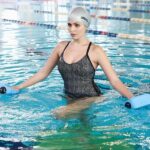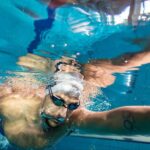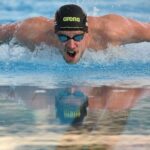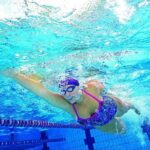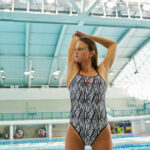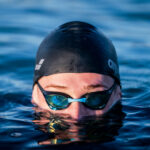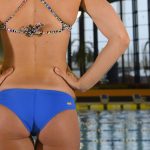Why You Need Triathlon Goggles and How to Choose Them
You might think any old pair of swimming goggles will work for your next triathlon, but there are key differences between pool swimming goggles and triathlon goggles. Triathletes swim in different conditions and train differently than swimmers who compete in a pool. That’s why triathletes should equip themselves with goggles designed to meet their needs.
In this article, you will learn about the different conditions triathletes swim in and how a pair of triathlon goggles can help you compete at a higher level. You’ll also learn how to distinguish between triathlon goggles and pool swimming goggles. After that, we will go over what you should look for in your next pair of triathlon goggles.
Pool Swimming vs. Open-Water Swimming
The swimming segment of most triathlons occurs in open water. Pools and open water are two very different venues in the sport of swimming. So, it makes sense that pool swimmers and open-water swimmers use different types of goggles to meet their specific needs. Below, we have outlined some of the differences you can expect when swimming one venue over the other.
The Conditions of a Pool
The conditions of a pool are controlled so that athletes can swim their fastest. From lighting to wave management to visibility, pools allow you to focus on technique and speed. Here are some of the ways pool conditions are controlled:
- Lane lines and modern drainage systems minimize the amount of waves created while you and your competitors swim.
- Swimming lines — the lines on the bottom of pools — help swimmers guide themselves in a straight line during each lap.
- Visibility is good in swimming pools because the lighting is controlled and the water is clear.
- During a swim event, you have a lane to yourself and do not have to worry about coming into physical contact with your opponents.
The Conditions of an Open-Water Triathlon Swim
Whether you are swimming in an ocean or a lake, the swimming conditions are far from optimal when compared to those found in a pool. During a triathlon, you must contend with extended amounts of time in the water, changing light conditions, and no swimming line to guide you to your destination. Let’s take a look at what to expect during a triathlon swim:
- When swimming in open water, especially in the ocean, you will have to contend with swells and currents during your competition.
- While swimming with your head down, there is nothing to guide you. You will have to raise your head out of the water to spot an object like a buoy or the shoreline to use as your guide.
- The lighting during an open-water swim depends on the time of day, what season it is, and the weather on the day of your race. So, visibility can range from sunny and optimal to cloudy and downright hard to see.
- You may come into physical contact with your competitors. Poor visibility and swells mixed with a crowd of swimmers can result in a fairly physical swim event.
With Different Venues, Comes Different Goggles
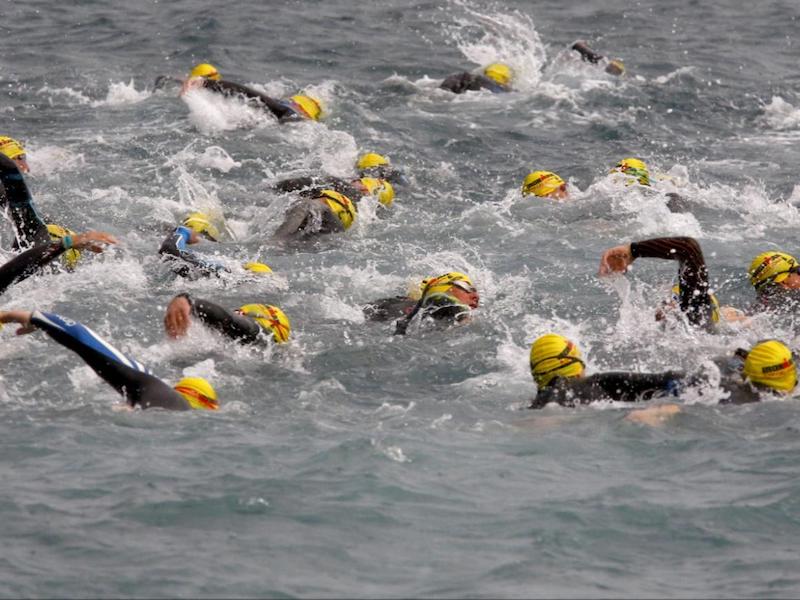
Now that you can see the difference between pool swimming and open-water swimming, you can begin to understand why a triathlete needs goggles that are slightly different from their pool swimming counterparts. Triathletes opt to use swim gear made specifically for their sport, like thermal wetsuits when conditions get cold. They also choose to use triathlon goggles. Let’s go over the main differences you will see between triathlon goggles and pool swimming goggles.
Pool Swimming Goggles: Built for Speed
- Pool swimming goggles tend to be more low-profile on your face, allowing for faster swim times, like Arena’s Cobra Ultra Swipe goggles. When the pool you are swimming in is optimized for speed, your equipment should be too.
- The lenses of these goggles are generally smaller. This helps with hydrodynamics. Since pool swimmers have a swimming line to follow, their field of vision does not need to be as broad.
- Some goggles do not have rubber or silicone gaskets. Known as Swedish goggles, these types of goggles are popular among pool swimmers but wouldn’t hold up well to the demands of open-water swimming.
- Pool swimming goggles that are specifically designed for indoor swimming might not have UV protection, though all Arena swim goggles are treated against UV rays.
Triathlon Goggles: Designed to Increase Visibility
- Triathlon goggles have larger lenses. While this makes these goggles less hydrodynamic, it greatly increases your field of vision, allowing you to spot buoys, the shoreline, or your competitors around you.
- The greater surface area of the lenses minimizes the risk of injury to your eye if a fellow competitor were to hit your goggle while taking a stroke.
- These goggles will always have silicone gaskets to ensure a tight fit on your eye socket. During long open-water swims, it is important to have goggles that will not leak.
- Goggles designed for triathletes are meant for outdoor use, meaning these lenses are better suited for the variable lighting conditions you might experience during a triathlon swim. Goggles may have tinted lenses, mirrored lenses, or lenses that are polarized.
- Most triathlon goggles provide UV protection. According to Ferris State University, without UV protection for your eyes, you could experience photokeratitis, which can cause pain and temporary vision loss. Over the long term, UV exposure could lead to cataracts or age-related macular degeneration. So, during long swims out in open water, you’ll want to protect your eyes from the sun.
- Many open-water goggles have an anti-fog coating on the lenses, something that is very beneficial for your ability to see. The Arena Cobra Tri Swipe Mirror Goggle is specifically designed with an anti-fog coating that lasts 10 times longer and can be “swiped” to reactivate it. This will limit the chances of needing to stop and clear your goggles because of a lens-fogging issue.
How to Find the Best Triathlon Goggle for You
Many of the characteristics of triathlon goggles that are defined above are what you should look for when searching for a new pair of goggles. Within the triathlon goggle market, there are a few preferential choices to be made, such as lens size, goggle type (mask or goggle), types of sun protection, and the fit you should be looking for.
Choose Your Lens Size
For lens size, you already know you should search for lenses that are larger than the ones found on typical swim goggles. However, there are many different goggles on the market, and lens size comes down to personal preference.
Remember, you will have greater visibility the larger the lens, something that is very advantageous during an open water race. Try out different goggles to see what works best for you.
Find the Best Goggle Style for You
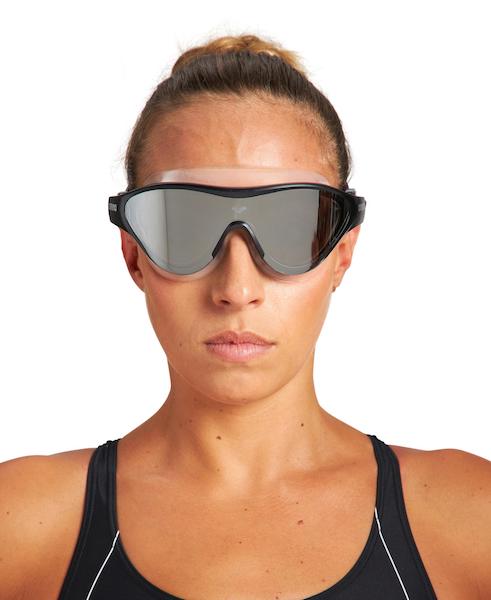
As for goggle type, you have two options: a goggle and a mask.
The first is a traditional style goggle consisting of two independent cups with a nose bridge connecting them. These goggles might feel more comfortable if you are used to pool goggles and will be slightly more hydrodynamic.
Your next option is a mask-style goggle. These goggles consist of one, slightly curved lens that allows for exceptional peripheral vision. The silicone gasket on mask-styled goggles creates an excellent seal on your face so you can avoid any water leakage. The single lens provides greater durability as you won’t have to worry about any snapping nose pieces.
Get the Right Lens for Those Sunny Days
Next, you will want to consider the lens type you need for sun protection. Sun protection for your eyes is a must for any outdoor swimming. Here are some things to look for:
- UV protection: Protect your eyes from harmful UV rays.
- Polarized lenses: A pair of polarized goggles will help you see better when the sun is glaring.
- Lens color/tint: You can choose a lighter or darker lens color depending on personal preference and the lighting conditions you will be swimming in. Generally, if it is bright outside, you will want a darker lens.
You can find goggles with some or all of these features. At the very least, you should select goggles that have UV protection so your eyes can remain healthy.
Don’t Forget About Those Not So Sunny Days
You might want to consider having multiple pairs of goggles. Along with your sunny-day goggles, consider getting a pair with clear lenses so you can see well when it is dark and rainy out as well.
You never know what time your next event will take place or what the weather will be like. You wouldn’t want to end up swimming an early race in the rain in a pair of dark-tinted goggles.
Find That Perfect Fit for Race Day
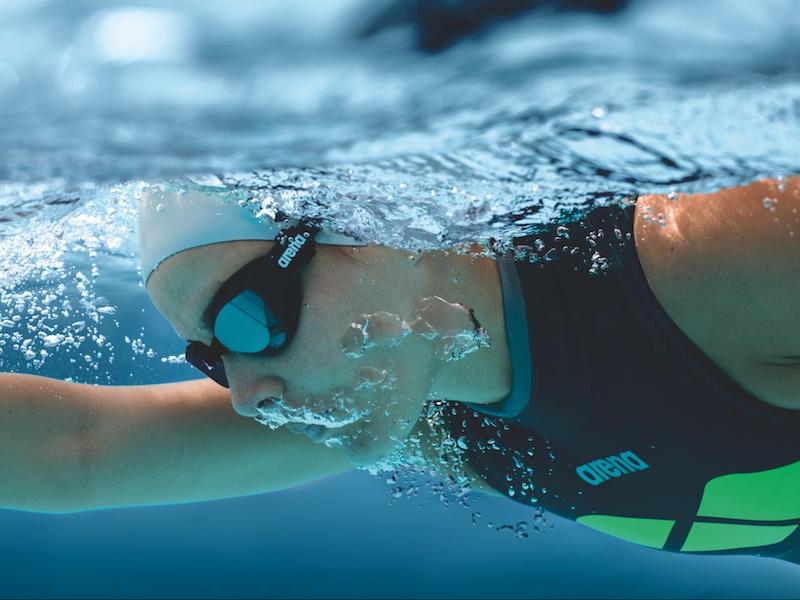
You will want to try on a few pairs of goggles so you can get an idea of what is most comfortable for your facial structure. Make sure the nose pieces do not rest on the bridge of your nose as this will cause discomfort. Ensure that the goggles have a secure seal on your face so no water can leak in.
Once you find goggles that have a good fit and do not leak, make sure you train in them! Training in the goggles will ensure you are comfortable competing in them, and it acts as a good test to double-check that they do not leak.
A good pair of triathlon goggles will be your best friend in your next open-water swim. Not only will they be comfortable and protect your eyes from the sun, but they will also help you see your surroundings with greater clarity.
After you have made your choice between the mask or goggle style and have chosen your desired lens type, be sure to view Arena’s full selection of goggles where you can find the right pair for your next triathlon.
Written by:
Harrison Howarth
Harrison is a freelance writer with a background in competitive aquatic sports. His love for water polo and swim, combined with his passion for writing and education, drives him to continue teaching and inspiring individuals to participate in aquatics.
